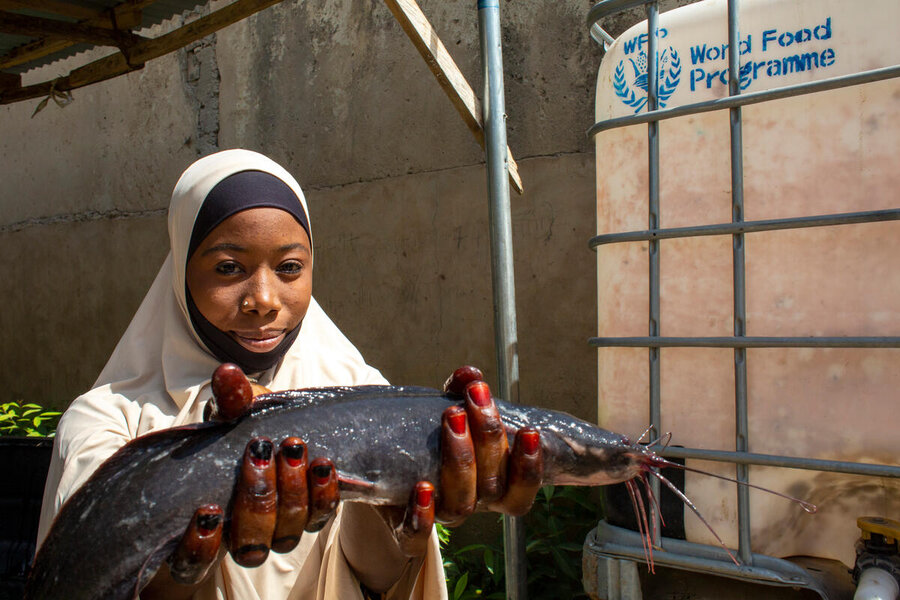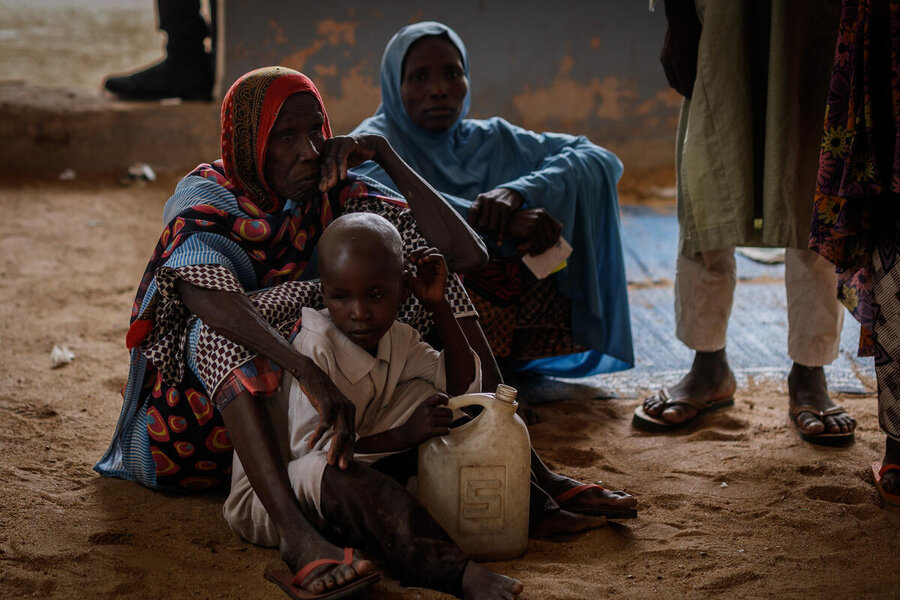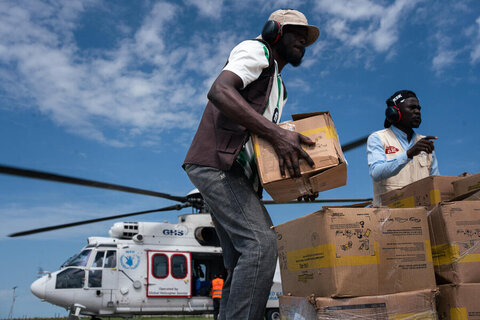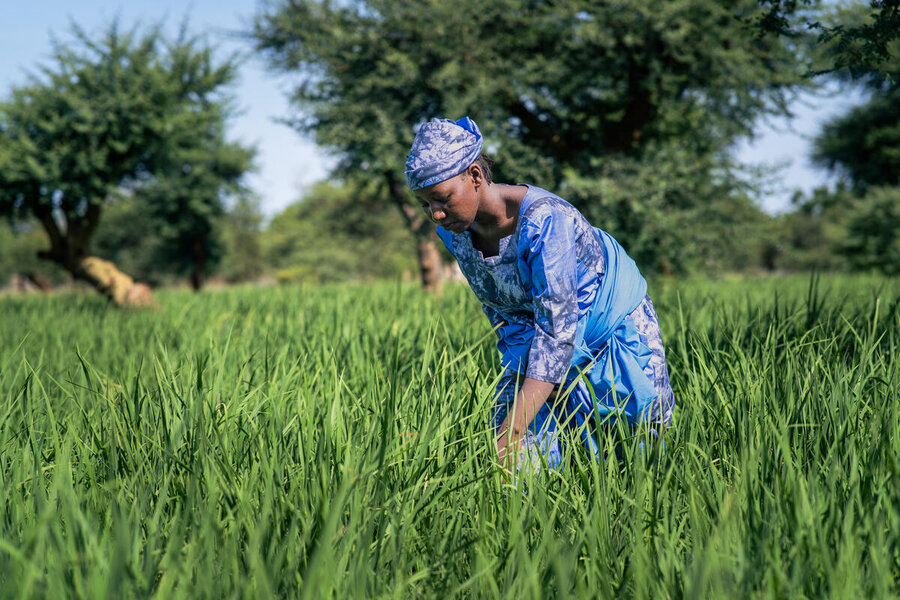Blog: Reflections on the hunger crisis in northern Nigeria

Humanitarian agencies are in a race against time to save lives in contexts where economies have collapsed as hunger is aggravated by conflicts and extreme weather, among other factors.
Take Nigeria, for example. Across the country lives and livelihoods are being shattered by conflict and climate shocks – once a breadbasket, the northern regions now rely heavily on humanitarian food assistance.
The numbers speak for themselves: 30.6 million people are food insecure – 10 million people in three northern states; 17 million children are malnourished – the highest number in Africa, second highest globally after India.
Farmers are cut off from their fields. Traders struggle to move goods through dangerous or impassable roads. Millions are displaced. And yet amid this fragility pockets of resilience are emerging in areas where conflict has subsided such that some farmers can return to their farms.
Positive news
Food assistance has saved millions of lives in northern Nigeria and contributed to the local agricultural economy – but not always systematically. But what if food assistance could do more than meet immediate needs? What if it became the catalyst for rebuilding food systems – revitalizing local economies, and laying the groundwork for durable peace and recovery?
(What are food systems? Everything from ‘farm to fork’ – it’s about having a broader picture of how we literally produce, transport, process and consume food.)
WFP’s shift from food aid to food assistance marked a major policy reform. In the case of Nigeria, by focusing on “assistance” rather than “aid”, WFP has enabled around U$200 million per year to be invested in Nigeria. This includes: locally purchased food, cash transfers for people to buy food in local markets, and e-vouchers redeemable with local retailers.

But there are still untapped opportunities to strengthen local food systems, restore markets, and build long-term resilience. For example, cash-based transfers can unintentionally undermine local agriculture when beneficiaries and retailers choose imported food. This allows imports to outcompete or displace local production.
On the other hand, local food procurement can stimulate production, strengthen markets, and complement private sector investment – even in fragile settings.
With the right policies and incentives, food assistance can do more than save lives – it can help rebuild economies and support long-term recovery. We can support the same people with food assistance and resilience at the same time.
Maintaining momentum
That’s certainly possible in spite of challenges – according to a forthcoming study from the World Food Programme (WFP), the African Development Bank (AfDB), and the International Food Policy Research Institute (IFPRI).
The joint WFP-AfDB-IFPRI study will show that even in conflict-affected areas, food systems are not broken everywhere. Farmers are planting in pockets of stability. Women’s cooperatives are processing food for local markets. Youth-led logistics enterprises are emerging. These islands of functionality offer something rare in fragile contexts: momentum. But maintaining momentum needs investment.
Nigeria’s north: navigating the complexities
In northern Nigeria, insecurity has fractured supply chains. Poor infrastructure, high transport costs, and post-harvest losses (up to 30–50 percent for some crops) are driving up food prices and hitting farmers’ incomes. Labour shortages resulting from people moving to escape conflict have pushed wages higher. Fertilizer and seed prices remain out of reach for most.
Reeling back Nigeria's hunger emergency

Despite these constraints, the region has extraordinary potential – spanning diverse agro-ecological zones with year-round production capacity. Demand for processed products is growing. Public investment, like the Government’s AfDB-supported wheat cultivation on over a million hectares, is scaling up. And innovations in climate-smart agriculture, digital input systems, and inclusive finance are taking root.
The lesson is clear: with the right investments, even fragile regions can transform their food systems. So, what needs to change?
Reimagining food systems
First, humanitarian food systems must be reimagined – from emergency pipelines to economic platforms. Local sourcing, tailored cash transfers, and co-investments in storage, processing, and logistics can turn assistance into a driver of resilience. The local purchase programme could be expanded so that it contributes as a humanitarian solution.
WFP’s Food System Influence Index is one example of how the agency is shifting toward food-system-sensitive operations – designed to advise on the contributions cash transfers and local food purchases can have on the local food system.
Structuring investments
Second, investments must be structured, not scattered. Too often, development plans stop at project lists. Typically missing are bankable investment portfolios. These portfolios should skillfully blend grant financing with concessional loans, specifically tailored to the unique challenges of fragile environments and supported by expert technical assistance on the ground.

This approach has yet to be implemented and requires meaningful engagement between the private sector, international financial institutions, and operational agencies such as WFP. Bundling road repair with off-grid processing, or linking farmer cooperatives to procurement hubs, can unlock scale and impact.
This is where AfDB’s infrastructure experience and IFPRI’s analytics add real value. This demands a shift towards a risk-adjusted return mindset, in other words, “profitability” – a concept familiar to the private sector but one that requires a progressive adaptation among humanitarian and development actors.
Backing farmers
It also requires the empowerment of small-scale farmers, engaging women and youth at the center of investment. Third, the real levers of resilience must be targeted: reducing post-harvest losses, improving input access, cutting transport costs, and modernizing processing.
Climate-smart technologies – such as solar-powered dryers, drought-tolerant seeds, and weather insurance – must be mainstreamed. And the informal taxation that bleeds value from food systems must be tackled.
Finally, recovery must be inclusive. Women and young people are central to food systems in fragile settings but face barriers gaining access to land, finance, and training. Targeted programmes – combined with broader policy reforms – are needed to unlock their economic potential.
From fragility to prosperity
The situation in northern Nigeria is a microcosm of a larger reality: humanitarian aid is essential, but not enough. It must be linked to long-term strategies for recovery and growth. With proper support, food systems can stabilize communities, create jobs, and build peace.
This is not only a development challenge. It is an investment opportunity. Structured correctly, food system investments can yield strong returns in fragile settings: reducing reliance on aid, improving nutrition, stimulating markets, and fostering political stability.
As governments, donors, and development partners look to scale support in fragile regions, the question is no longer whether we can afford to invest – but whether we can afford not to.
Northern Nigeria offers a stark illustration of both the high stakes involved and the transformative possibilities that lie ahead, demanding our focused attention and decisive action.
Co-authored by David Stevenson, WFP Country Director in Nigeria; Dr Abdul Kamara, African Development Bank Director General for Nigeria; Dr Yero Baldeh, AfDB Director of the Transition States Department; Dr Martin Fregene, AfDB Director of Agriculture and Agro-Industry; Dr Steven Were Omamo, International Food Policy Research Institute Director for Africa.
